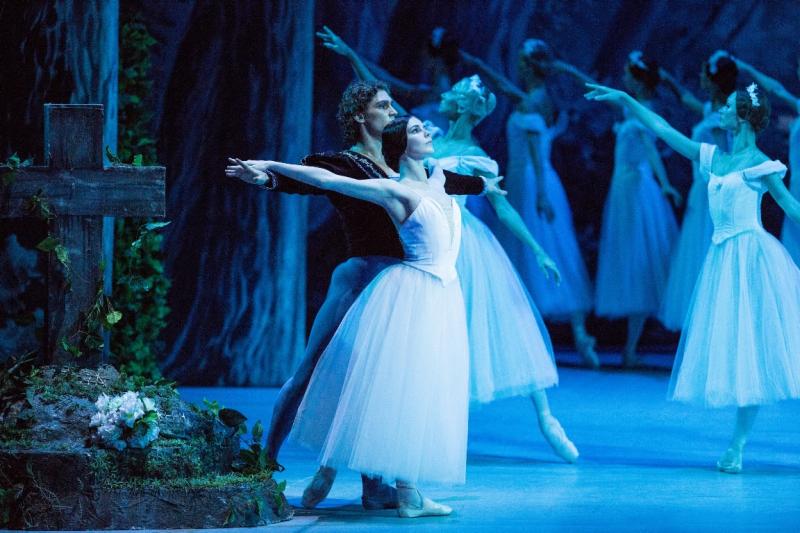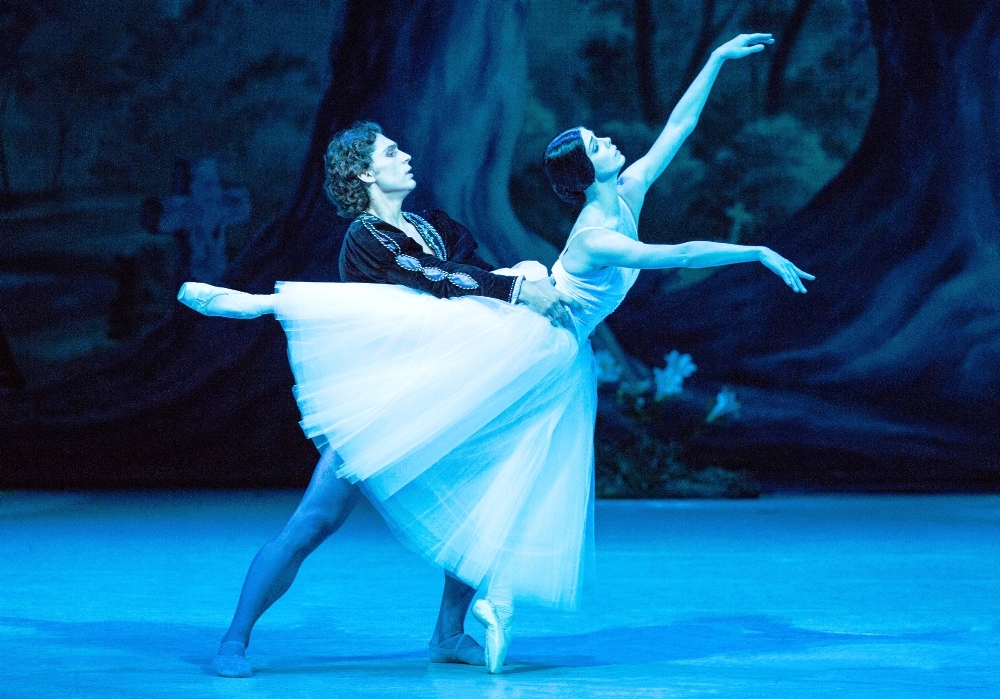Giselle, Mikhailovsky Ballet, London Coliseum | reviews, news & interviews
Giselle, Mikhailovsky Ballet, London Coliseum
Giselle, Mikhailovsky Ballet, London Coliseum
A good basic production - with a stellar duo in front

When the Bolshoi’s wunderkinder, Natalia Osipova and Ivan Vasiliev, suddenly left the company two years ago, the dance world played endless guessing-games as to where they would end up. It was like Claude Rains in Casablanca: round up the usual suspects.
What drew them? Well, the company has an extraordinary Soviet heritage, playing host to some of the great names of 1930s experimental dance. It probably helps, too, that it is now funded by an oligarch, and, with the appointment of the Spaniard Nacho Duato, he provided that greatest of rarities in Russia, a non-Russian artistic director, who brought with him some of his own choreography and the possibility of a varied repertoire.
 This two-week London season starts more traditionally, with Nikita Dolgushin’s straight-down-the-line production of Giselle. Osipova and Vasiliev were both straitjacketed at the Bolshoi, she guided entirely into soubrette roles, he limited to the gaudy delights of Grigorovich’s Spartacus and other pieces of heroic Soviet posturing. So Giselle is a defiant gesture of the breadth of their ambition.
This two-week London season starts more traditionally, with Nikita Dolgushin’s straight-down-the-line production of Giselle. Osipova and Vasiliev were both straitjacketed at the Bolshoi, she guided entirely into soubrette roles, he limited to the gaudy delights of Grigorovich’s Spartacus and other pieces of heroic Soviet posturing. So Giselle is a defiant gesture of the breadth of their ambition.
The evening is Osipova’s (no-one ever staged Giselle because they had a damn fine Albrecht any more than Hamlet is produced because the director has the perfect Gertrude.) Her first act is well thought through, with some lovely moments – when she plays "He loves me, he loves me not" with a daisy, and finds that it comes out to "not", she steps back, flat-footed, prefiguring her mad scene later. In the mad scene itself, after she chases the invisible something in the air, her arms end crossed in the Wilis' stance – the ghosts are already calling to her. And her fluttering, spidery hands clutch desperation from the air, even as she automatically bobs a curtsey to Berthe as she passes.
But it is Act II where her performance deepens, from one of fleet technique and carefully considered acting, to mine the real emotional core of this piece. Giselle has survived for so long because it is multi-layered, yet it is too often played flatly: Giselle is a loving girl, she is betrayed, she dies, she returns to rescue her lover. That’s nice, and sweetly sentimental, but it is not Théophile Gautier’s really quite creepy story. In the original, Giselle dies and she returns, but only part of her wants to save her lover; the other part is already a Wili, and it wants to lure her betrayer to his death.
A couple of pieces of overhanging ivy spent much of Act II going up and down like a bride’s nightie
Osipova conveys that dichotomy with eerie ferocity. Her first entry is breathtaking in its virtuosity – rarely have I seen turns of such speed, jumps of such height. Yet it is subordinate to, and in the service of, the drama. When she circles Albrecht, who is not yet aware of her, she is not protecting him, she is marking her territory. The unvarying monotonous perfection of her (enormous) entrechats makes her a puppet of her masters, the Wilis. And as she beckons him, and makes him dance once more, she is loving and caring – and she is carrion, hovering over his doomed body.
Vasiliev was a willing partner, playing an Albrecht of youthful impetuosity and foolishness, rather than of devious betrayal. The Act II partnering could have been smoother, more invisible, but his solos were remarkable yet never broke the spell of the drama to become virtuoso turns, to the detriment of the story.
Myrtha (Ekaterina Borchenko), too, was a steely dramatic foil, and the corps of 24 all they should have been. Olga Semyonova played Bertha with camp vigour, a red-headed Mae West with a riding-crop.
A few bits of clunk will no doubt shortly be ironed out – technical stutters meant a couple of pieces of overhanging ivy spent much of Act II going up and down like a bride’s nightie, and it would be nice if Hilarion (the touching Vladimir Tsal) and Albrecht found somewhere other than Giselle’s grave to abandon their coats and hats: it began to feel like the foyer cloakroom. But on the whole this was a good basic production fronted by two stellar performers.
Buy
Explore topics
Share this article
Add comment
The future of Arts Journalism
You can stop theartsdesk.com closing!
We urgently need financing to survive. Our fundraising drive has thus far raised £49,000 but we need to reach £100,000 or we will be forced to close. Please contribute here: https://gofund.me/c3f6033d
And if you can forward this information to anyone who might assist, we’d be grateful.

Subscribe to theartsdesk.com
Thank you for continuing to read our work on theartsdesk.com. For unlimited access to every article in its entirety, including our archive of more than 15,000 pieces, we're asking for £5 per month or £40 per year. We feel it's a very good deal, and hope you do too.
To take a subscription now simply click here.
And if you're looking for that extra gift for a friend or family member, why not treat them to a theartsdesk.com gift subscription?
more Dance
 'We are bowled over!' Thank you for your messages of love and support
Much-appreciated words of commendation from readers and the cultural community
'We are bowled over!' Thank you for your messages of love and support
Much-appreciated words of commendation from readers and the cultural community
 How to be a Dancer in 72,000 Easy Lessons, Teaċ Daṁsa review - a riveting account of a life in dance
Michael Keegan-Dolan's unique hybrid of physical theatre and comic monologue
How to be a Dancer in 72,000 Easy Lessons, Teaċ Daṁsa review - a riveting account of a life in dance
Michael Keegan-Dolan's unique hybrid of physical theatre and comic monologue
 A Single Man, Linbury Theatre review - an anatomy of melancholy, with breaks in the clouds
Ed Watson and Jonathan Goddard are extraordinary in Jonathan Watkins' dance theatre adaptation of Isherwood's novel
A Single Man, Linbury Theatre review - an anatomy of melancholy, with breaks in the clouds
Ed Watson and Jonathan Goddard are extraordinary in Jonathan Watkins' dance theatre adaptation of Isherwood's novel
 Peaky Blinders: The Redemption of Thomas Shelby, Rambert, Sadler's Wells review - exciting dancing, if you can see it
Six TV series reduced to 100 minutes' dance time doesn't quite compute
Peaky Blinders: The Redemption of Thomas Shelby, Rambert, Sadler's Wells review - exciting dancing, if you can see it
Six TV series reduced to 100 minutes' dance time doesn't quite compute
 Giselle, National Ballet of Japan review - return of a classic, refreshed and impeccably danced
First visit by Miyako Yoshida's company leaves you wanting more
Giselle, National Ballet of Japan review - return of a classic, refreshed and impeccably danced
First visit by Miyako Yoshida's company leaves you wanting more
 Quadrophenia, Sadler's Wells review - missed opportunity to give new stage life to a Who classic
The brilliant cast need a tighter score and a stronger narrative
Quadrophenia, Sadler's Wells review - missed opportunity to give new stage life to a Who classic
The brilliant cast need a tighter score and a stronger narrative
 The Midnight Bell, Sadler's Wells review - a first reprise for one of Matthew Bourne's most compelling shows to date
The after-hours lives of the sad and lonely are drawn with compassion, originality and skill
The Midnight Bell, Sadler's Wells review - a first reprise for one of Matthew Bourne's most compelling shows to date
The after-hours lives of the sad and lonely are drawn with compassion, originality and skill
 Ballet to Broadway: Wheeldon Works, Royal Ballet review - the impressive range and reach of Christopher Wheeldon's craft
The title says it: as dancemaker, as creative magnet, the man clearly works his socks off
Ballet to Broadway: Wheeldon Works, Royal Ballet review - the impressive range and reach of Christopher Wheeldon's craft
The title says it: as dancemaker, as creative magnet, the man clearly works his socks off
 The Forsythe Programme, English National Ballet review - brains, beauty and bravura
Once again the veteran choreographer and maverick William Forsythe raises ENB's game
The Forsythe Programme, English National Ballet review - brains, beauty and bravura
Once again the veteran choreographer and maverick William Forsythe raises ENB's game
 Sad Book, Hackney Empire review - What we feel, what we show, and the many ways we deal with sadness
A book about navigating grief feeds into unusual and compelling dance theatre
Sad Book, Hackney Empire review - What we feel, what we show, and the many ways we deal with sadness
A book about navigating grief feeds into unusual and compelling dance theatre
 Balanchine: Three Signature Works, Royal Ballet review - exuberant, joyful, exhilarating
A triumphant triple bill
Balanchine: Three Signature Works, Royal Ballet review - exuberant, joyful, exhilarating
A triumphant triple bill
 Romeo and Juliet, Royal Ballet review - Shakespeare without the words, with music to die for
Kenneth MacMillan's first and best-loved masterpiece turns 60
Romeo and Juliet, Royal Ballet review - Shakespeare without the words, with music to die for
Kenneth MacMillan's first and best-loved masterpiece turns 60

Comments
The ivy going up and down in
Really? How bizarre and
You imply that Osipova was
I was really trying to say